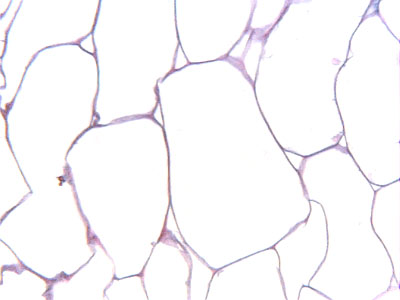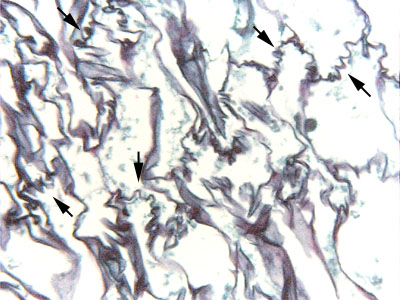 Fig.
11.3-9. Transverse section of a cactus stem (Borzicactus
humboldtii; no common name). Many, but not all, cacti have what is known as collapsible cortex: part of the cortex has walls that can flex and
wrinkle, allowing the cells to collapse to a very small size without damaging
themselves or their walls. The arrows in the lower micrograph point
out just a few areas where the walls are extremely plicate. Although the cells
in the lower micrograph look terrible, as if fixed and processed improperly
perhaps, or maybe taken from a dead plant, this is the way the cells of the
collapsible cortex look when they are collapsed. If the plant had been given
water, or if the sample had been collected in the rainy season, the cells of the
lower micrograph would have been full of water, swollen again and looking much
like the cells of the upper micrograph; collapsible cells can go through this
cycle many times without being harmed. In many other parts of the cortex, the
cells are not like this, their walls will not fold easily (upper micrograph).
Consequently, the cortex has several regions: a region of collapsible cells that
give up their water very easily and a region of more resistant cells. As the
stem begins to lose water in a drought, it is the collapsible cells that give up
water first, shrinking as they do so, and remaining healthy. The resistant cells
will absorb that water and remain fully hydrated: even though the plant is
losing water, the resistant cells are not losing any. You can guess which cortex
cells are resistant: the photosynthetic outer cortex chlorenchyma cells and the
cortex cells immediately adjacent to the phloem (the cells in the upper
micrograph are only a few micrometers away from the phloem).
Fig.
11.3-9. Transverse section of a cactus stem (Borzicactus
humboldtii; no common name). Many, but not all, cacti have what is known as collapsible cortex: part of the cortex has walls that can flex and
wrinkle, allowing the cells to collapse to a very small size without damaging
themselves or their walls. The arrows in the lower micrograph point
out just a few areas where the walls are extremely plicate. Although the cells
in the lower micrograph look terrible, as if fixed and processed improperly
perhaps, or maybe taken from a dead plant, this is the way the cells of the
collapsible cortex look when they are collapsed. If the plant had been given
water, or if the sample had been collected in the rainy season, the cells of the
lower micrograph would have been full of water, swollen again and looking much
like the cells of the upper micrograph; collapsible cells can go through this
cycle many times without being harmed. In many other parts of the cortex, the
cells are not like this, their walls will not fold easily (upper micrograph).
Consequently, the cortex has several regions: a region of collapsible cells that
give up their water very easily and a region of more resistant cells. As the
stem begins to lose water in a drought, it is the collapsible cells that give up
water first, shrinking as they do so, and remaining healthy. The resistant cells
will absorb that water and remain fully hydrated: even though the plant is
losing water, the resistant cells are not losing any. You can guess which cortex
cells are resistant: the photosynthetic outer cortex chlorenchyma cells and the
cortex cells immediately adjacent to the phloem (the cells in the upper
micrograph are only a few micrometers away from the phloem).
This
phenomenon is newly discovered and is not in any current anatomy book; for more
information, see:
Mauseth,
J. D. 1995. Collapsible water-storage cells in cacti. Bulletin of the Torrey
Botanical Club 122: 145-151.